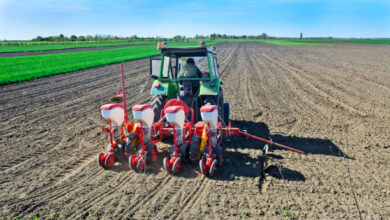
The role of agriculture in economic development is often underestimated and overlooked. Agriculture is, in fact, one of the most powerful forces for building nations, providing employment, food security, and economic opportunities for billions of people around the world. This blog post will explore the many ways that agricultural activities, such as crop production, livestock rearing, forestry, and fisheries, are essential for development and creating a thriving economy. Through discussions of the history, current trends, and future outlook of agriculture, this post aims to demonstrate why it plays such an important role in economic progress.
Agriculture as a Catalyst for Economic Growth
Agriculture serves as a powerful catalyst for economic growth, laying the foundation for development in countries around the world. Its impact goes far beyond the fields and farms, influencing every sector of the economy. When agriculture flourishes, economies thrive.
Firstly, agriculture drives economic growth by generating employment opportunities. It provides jobs not only in farming, but also in related industries such as agribusiness, food processing, and distribution. The ripple effect of agricultural activities creates a demand for labor and stimulates rural economies.
Furthermore, agriculture contributes to economic growth by improving the balance of trade. By exporting agricultural products, countries can earn valuable foreign exchange. This influx of currency strengthens their economy and enables them to import goods and services to meet the needs of their population.
Moreover, agriculture is a vital source of revenue for governments. Taxes on agricultural income and agricultural exports contribute to government revenue, enabling them to invest in infrastructure, education, healthcare, and other essential services.
Additionally, agriculture promotes economic growth by fostering innovation and technological advancements. Farmers and scientists continuously develop new techniques, technologies, and crop varieties that increase productivity and efficiency in the agricultural sector. These innovations spill over into other industries, driving overall economic growth and competitiveness.

Job Creation and Employment Opportunities
Agriculture plays a significant role in creating job opportunities and stimulating employment, making it a vital sector for economic development. From farmers and agricultural laborers to workers in agribusiness, food processing, and distribution, the agricultural industry provides employment to a large portion of the global population.
In developing countries, where agriculture often forms the backbone of the economy, job creation in this sector is particularly crucial. Rural areas heavily rely on agricultural activities, and by generating employment opportunities, agriculture helps to reduce poverty and promote economic growth in these regions.
Moreover, the ripple effect of agricultural activities extends beyond the farms and fields. As the agricultural sector grows, it creates a demand for labor in other industries as well. From transportation and logistics to packaging and marketing, various sectors benefit from the agricultural supply chain. This generates a positive cycle of job creation and economic growth.
Additionally, agriculture offers a diverse range of job opportunities, catering to individuals with different skill sets and education levels. While some jobs may require technical knowledge in areas such as crop management or livestock rearing, others may involve marketing, finance, or research and development. This versatility ensures that there are opportunities for people with varying backgrounds and qualifications.
Overall, the agricultural sector is a significant contributor to employment, particularly in rural areas. By generating job opportunities, agriculture helps to reduce unemployment, alleviate poverty, and create a more inclusive and prosperous economy.
Improving Food Security and Reducing Hunger
In a world where millions of people still go hungry, agriculture plays a crucial role in improving food security and reducing hunger. By increasing agricultural productivity and ensuring a steady food supply, we can work towards a future where everyone has access to nutritious meals.
One of the primary ways agriculture addresses food security is through increased food production. Farmers around the world work tirelessly to grow crops and raise livestock, ensuring a constant supply of food. By implementing sustainable farming practices and utilizing modern techniques, agriculture can maximize yields and meet the demands of a growing population.
Furthermore, agricultural diversity is essential in reducing hunger. By cultivating a variety of crops, farmers can mitigate the risks of crop failure due to pests, diseases, or adverse weather conditions. Diversifying food sources also ensures a more balanced and nutritious diet for individuals, contributing to better overall health.
Improving food storage and transportation infrastructure is another critical aspect of enhancing food security. By investing in cold storage facilities, warehouses, and efficient transportation networks, we can minimize post-harvest losses and ensure that food reaches those who need it most.
Addressing hunger also requires addressing poverty. Investing in agriculture provides income opportunities for farmers, allowing them to access nutritious food and improve their livelihoods. Additionally, empowering small-scale farmers through access to resources, training, and market opportunities can have a significant impact on reducing hunger in rural communities.
To truly achieve food security and reduce hunger, it is essential to foster partnerships between governments, NGOs, and the private sector. By working together, we can implement effective policies and programs that address the root causes of hunger and ensure a sustainable food system for future generations.

Promoting Rural Development and Poverty Alleviation
Rural development and poverty alleviation are two critical issues that agriculture can address. In many countries, especially developing ones, rural areas are often the most impoverished, with limited access to basic amenities and economic opportunities. Agriculture can play a vital role in promoting rural development and lifting people out of poverty.
By investing in agricultural infrastructure and providing resources and training to farmers, governments can create an enabling environment for rural development. Access to modern farming techniques, improved irrigation systems, and quality seeds can significantly increase agricultural productivity, leading to higher incomes for farmers. This, in turn, stimulates economic activity in rural areas, creating employment opportunities and reducing poverty.
Agriculture can also foster entrepreneurship in rural communities. By promoting value-added activities such as agro-processing and food manufacturing, farmers can diversify their income streams and create new businesses. This not only boosts the local economy but also empowers individuals and communities to take control of their economic destiny.
Furthermore, agricultural development can enhance rural infrastructure, such as roads, electricity, and healthcare facilities. As agricultural activities expand, there is a need for better transportation networks to facilitate the movement of goods to markets. Access to reliable electricity and healthcare services can improve the quality of life for rural residents, attracting investment and promoting overall development.
It is important to recognize that promoting rural development and poverty alleviation through agriculture requires a comprehensive approach. This includes targeted policies, investment in education and skills training, access to credit and financial services, and the inclusion of marginalized groups, such as women and small-scale farmers. By addressing these challenges, agriculture can truly become a catalyst for rural development and poverty reduction.

Encouraging Export Trade and Boosting Foreign Exchange Earnings
Agriculture plays a crucial role in encouraging export trade and boosting foreign exchange earnings for countries around the world. Through the export of agricultural products, nations can generate valuable foreign currency that strengthens their economy and allows them to meet the needs of their population.
The export of agricultural products provides a significant source of revenue for countries. By selling crops, livestock, forestry products, and fisheries to international markets, nations can earn valuable foreign exchange that can be used to import goods and services. This not only contributes to the growth of the economy but also improves the standard of living for citizens.
Additionally, encouraging export trade in agriculture creates opportunities for farmers and agribusinesses to expand their markets. By tapping into global demand, agricultural producers can increase their production and sales, driving economic growth in the sector. This, in turn, creates employment opportunities and stimulates rural economies.
Furthermore, exporting agricultural products can enhance a country’s international reputation and competitiveness. By showcasing high-quality produce and meeting global standards, nations can attract foreign investment and establish themselves as reliable trading partners. This can lead to partnerships and collaborations with other countries, fostering innovation and technological advancements in the agricultural sector.
To encourage export trade and boost foreign exchange earnings, governments can implement policies that support farmers and agribusinesses in accessing international markets. This includes providing training and resources, improving infrastructure and logistics, and promoting trade agreements and partnerships. By creating an enabling environment for agricultural exports, nations can harness the full potential of agriculture in driving economic development.
Advancements in Agriculture Technology and Innovation
Advancements in agriculture technology and innovation have revolutionized the way we produce and manage crops, livestock, and other agricultural activities. These developments have played a crucial role in boosting agricultural productivity, increasing efficiency, and ensuring sustainable practices.
One major advancement is the use of precision agriculture techniques. With the help of GPS technology, farmers can now precisely monitor and analyze the needs of their crops, such as irrigation, fertilization, and pest control. This allows for targeted and efficient use of resources, reducing waste and improving yields.
Another important innovation is the use of biotechnology in agriculture. Genetic engineering has enabled the development of crops that are resistant to pests, diseases, and adverse environmental conditions. This not only ensures a more stable food supply but also reduces the need for harmful pesticides and herbicides.
In recent years, there has also been significant progress in the field of robotics and automation in agriculture. Autonomous drones and robots can now assist in various farming tasks, such as planting, harvesting, and monitoring crop health. Furthermore, advancements in data analytics and artificial intelligence have transformed agriculture. Farmers can now collect and analyze vast amounts of data, enabling them to make data-driven decisions and optimize their operations. This includes predicting crop yields, managing inventory, and even forecasting market trends.
These advancements in agriculture technology and innovation hold great promise for the future of farming. By embracing these tools and techniques, farmers can increase productivity, reduce environmental impact, and ensure a sustainable food system. It is crucial for governments, researchers, and industry leaders to continue investing in research and development in order to unlock the full potential of these advancements and drive agricultural progress for generations to come.

Challenges and Solutions in Agriculture Development
Agriculture development faces several challenges that need to be addressed in order to maximize its potential in driving economic progress. One of the primary challenges is climate change and its impact on agricultural productivity. Rising temperatures, unpredictable weather patterns, and increased occurrences of extreme weather events pose a significant threat to crops, livestock, and overall food production. To tackle this challenge, investments in research and development are needed to develop climate-resilient crops and innovative farming techniques that can withstand these changing conditions.
Another challenge is the lack of access to resources and technology for small-scale farmers, especially in developing countries. Limited access to credit, land, modern machinery, and irrigation systems hinders their ability to increase productivity and profitability. Governments and international organizations can play a crucial role in providing support and resources to these farmers, such as implementing microfinance programs, providing training and education, and facilitating access to markets.
Furthermore, the issue of food waste and post-harvest losses is a significant challenge that needs to be addressed. A significant portion of the global food supply is wasted due to inadequate storage, transportation, and processing facilities. Investments in infrastructure and technologies for proper storage, preservation, and transportation can help reduce these losses and ensure that food reaches those in need.
Additionally, the rapid urbanization and migration of rural populations pose challenges for agriculture development. As people move to cities in search of better opportunities, there is a decline in the agricultural workforce, which can lead to a decrease in food production. Policies that encourage young people to pursue careers in agriculture, provide incentives for farmers to adopt modern technologies, and improve market linkages between rural and urban areas can help address this challenge.
Overall, addressing these challenges requires a multi-faceted approach involving collaboration between governments, international organizations, researchers, and farmers themselves. By investing in research and innovation, providing access to resources and technology, and implementing supportive policies, we can overcome these challenges and ensure that agriculture continues to play a powerful role in building nations and driving economic development.





Would you be keen on exchanging hyperlinks?
Merely a smiling visitor here to share the love (:, btw outstanding style. “Better by far you should forget and smile than that you should remember and be sad.” by Christina Georgina Rossetti.
Thank you a bunch for sharing this with all of us you actually recognize what you are talking about! Bookmarked. Kindly also seek advice from my website =). We will have a link change arrangement among us!
There is perceptibly a lot to realize about this. I consider you made certain nice points in features also.
Hi there are using WordPress for your blog platform? I’m new to the blog world but I’m trying to get started and set up my own. Do you need any coding knowledge to make your own blog? Any help would be greatly appreciated!
Do you mind if I quote a couple of your articles as long as I provide credit and sources back to your blog? My blog site is in the very same area of interest as yours and my visitors would truly benefit from a lot of the information you provide here. Please let me know if this ok with you. Cheers!
I like this post, enjoyed this one regards for posting. “He removes the greatest ornament of friendship, who takes away from it respect.” by Cicero.
Hi , I do believe this is an excellent blog. I stumbled upon it on Yahoo , i will come back once again. Money and freedom is the best way to change, may you be rich and help other people.
Just wanna comment on few general things, The website design is perfect, the content is very superb. “The enemy is anybody who’s going to get you killed, no matter which side he’s on.” by Joseph Heller.
Regards for this wondrous post, I am glad I noticed this web site on yahoo.
Thanks for the auspicious writeup. It in fact was once a entertainment account it. Glance complex to more introduced agreeable from you! However, how can we keep in touch?
I conceive this web site has got some real good information for everyone. “Dealing with network executives is like being nibbled to death by ducks.” by Eric Sevareid.
Hi there would you mind letting me know which webhost you’re using? I’ve loaded your blog in 3 different web browsers and I must say this blog loads a lot faster then most. Can you suggest a good internet hosting provider at a reasonable price? Thanks a lot, I appreciate it!
Great write-up, I am normal visitor of one?¦s website, maintain up the nice operate, and It’s going to be a regular visitor for a lengthy time.
I’m curious to find out what blog platform you have been working with? I’m having some small security issues with my latest site and I’d like to find something more safeguarded. Do you have any solutions?
When I originally commented I clicked the -Notify me when new comments are added- checkbox and now each time a comment is added I get four emails with the same comment. Is there any way you can remove me from that service? Thanks!